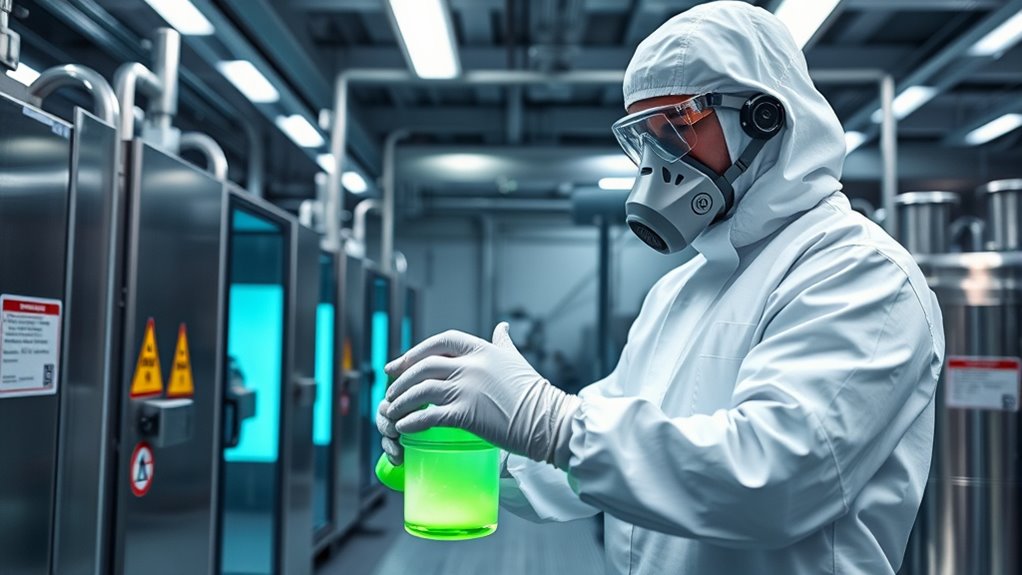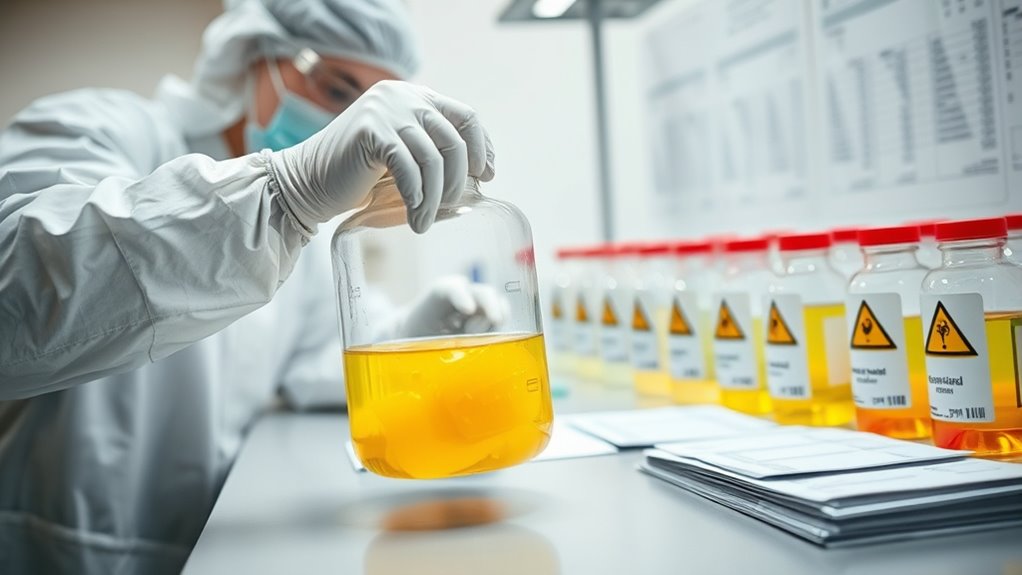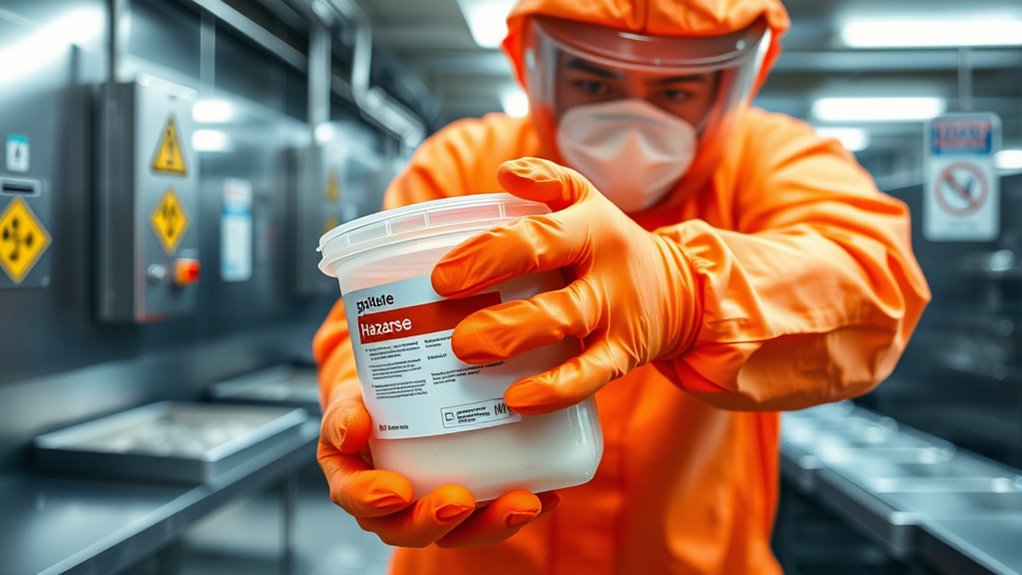When handling hazardous waste from splitters, you must identify the waste type—ignitable, corrosive, reactive, or toxic—and properly label and document everything. Wear appropriate PPE like gloves, goggles, and respirators, and use compatible containers stored away from hazards. Segregate waste to prevent reactions, ensure safe transport with clear labels, and comply with disposal regulations. For detailed safety practices and protocols, continue exploring effective waste management techniques to maintain safety and environmental compliance.
Key Takeaways
- Properly identify and label hazardous waste streams during collection, including characteristics like ignitable, corrosive, reactive, or toxic.
- Use appropriate PPE and compatible, sealed containers for safe handling, storage, and segregation of waste by hazard class.
- Ensure waste is stored in designated areas with clear labeling, and segregate incompatible wastes to prevent dangerous reactions.
- Verify waste classification and obtain necessary permits before transportation and disposal, following regulatory requirements.
- Maintain detailed records of waste generation, transfer, disposal, and staff training to ensure compliance and facilitate emergency response.
Understanding the Types of Hazardous Waste From Splitters

Splitters generate various types of hazardous waste that you need to recognize and manage properly. Understanding hazardous waste classification helps you categorize waste streams accurately, ensuring proper disposal and compliance. Waste stream analysis is essential in this process, as it identifies the specific characteristics of each waste type produced during splitting operations. You’ll need to determine whether waste is ignitable, corrosive, reactive, or toxic, which influences handling procedures. Proper classification allows you to implement appropriate storage, labeling, and treatment methods. By analyzing the waste stream, you’ll gain insight into potential risks and necessary safety measures. Recognizing these different hazardous waste types early helps prevent environmental contamination and ensures safe, compliant disposal practices throughout your operations. Incorporating hazardous waste management principles is also crucial to maintain safety and environmental standards.
Identifying Proper Personal Protective Equipment (PPE)

When working with hazardous waste from splitters, it’s crucial to identify and wear the appropriate personal protective equipment (PPE) to safeguard yourself from exposure. Your safety apparel and personal protective gear are critical in preventing contact with harmful substances. Always choose PPE suited for the specific hazards involved. The table below highlights key items:
| PPE Item | Purpose | Example |
|---|---|---|
| Gloves | Protect skin from chemicals | Nitrile or rubber gloves |
| Eye Protection | Prevent splashes or vapors | Safety goggles or face shield |
| Respirators | Filter airborne contaminants | Half-mask or full-face respirator |
Ensuring you select the correct safety apparel and personal protective gear helps minimize risk during waste handling. Regularly inspect PPE for damage before use. Proper hazard assessment is essential to determine the appropriate PPE required for each task.
Safe Collection and Segregation of Waste Materials

To guarantee safety, you need to follow proper labeling procedures for all waste containers. Segregate waste by hazard type to prevent dangerous reactions, and always store materials using safe practices. These steps protect you and others from potential risks associated with hazardous waste. Additionally, understanding cookie categories can help you manage online privacy and security effectively.
Proper Labeling Procedures
Proper labeling is vital to guarantee safe collection and segregation of hazardous waste materials from splitters. Accurate labels help ensure everyone handling the waste understands its contents, reducing the risk of accidents. Focus on labeling accuracy by clearly indicating the waste type, date of collection, and any hazards. Use consistent color coding to quickly identify waste categories; for example, red for flammable materials or yellow for corrosive substances. Attach labels securely to containers, making sure they’re visible and legible at all times. Proper labeling prevents cross-contamination and mishandling, safeguarding workers and the environment. Regularly check labels for damage or fading, replacing them immediately if needed. Implementing proper documentation ensures traceability and compliance with safety regulations. Clear, accurate labels are a key part of managing hazardous waste responsibly and safely.
Segregation by Hazard Type
Segregating hazardous waste by hazard type is crucial for safe collection and handling. You must accurately perform hazard identification to determine the specific risks associated with each waste material. Proper waste classification helps you sort materials into appropriate categories, such as flammable, corrosive, toxic, or reactive. By doing this, you prevent dangerous reactions and reduce exposure risks. Use clearly marked containers for each hazard class, ensuring that incompatible wastes are kept apart. Consistent segregation minimizes the chances of spills, leaks, or accidents during collection. Always follow your facility’s waste classification procedures and consult safety data sheets when unsure. Proper segregation not only protects your team but also ensures compliance with environmental regulations. This careful process is essential for maintaining a safe, efficient waste handling operation. Implementing color-coded labeling can further enhance the accuracy of waste segregation and reduce errors.
Storage Safety Practices
Effective storage practices are essential for maintaining safety during the collection and segregation of hazardous waste materials. You should use dedicated storage containers that are compatible with the waste type and clearly labeled with hazard signage. Proper containers prevent leaks and accidental mixing, reducing risks of exposure or reactions. Always ensure that containers are tightly sealed and stored in well-ventilated areas away from ignition sources. Segregate waste based on hazard class to prevent dangerous interactions. Regularly inspect storage containers for damage or leaks, and promptly replace or repair them. Clear hazard signage alerts personnel to the risks involved and reinforces safe handling procedures. Adhering to proper storage protocols also supports compliance with safety regulations, minimizing accidents, protecting health, and guaranteeing safety standards are met.
Handling and Storage Procedures for Hazardous Waste

Handling and storage of hazardous waste from splitters require strict adherence to safety protocols to prevent leaks, spills, or accidental exposure. You should always use compatible, clearly labeled containers designed for hazardous waste. Minimize waste whenever possible by implementing waste minimization practices, which reduce the volume of hazardous waste generated. Proper handling involves using personal protective equipment and following established procedures to prevent accidents. Store waste in secure, ventilated areas away from incompatible materials or sources of ignition. Regular inspections help identify leaks or deterioration in storage containers. Recycling hazardous waste when feasible supports environmental safety and reduces disposal needs. Additionally, understanding the types of hazardous waste generated can improve management practices and ensure compliance with regulations. Always follow your facility’s safety guidelines and local regulations to ensure safe handling and storage, protecting both personnel and the environment.
Labeling and Documentation Requirements

Proper labeling and thorough documentation are essential for guaranteeing safe and compliant management of hazardous waste from splitters. Adhere to labeling standards by clearly marking containers with the waste’s identity, hazards, and date of accumulation. Use durable labels that withstand environmental conditions to prevent misinterpretation. Documentation best practices involve maintaining detailed records of waste generation, transfer, and disposal activities. Keep accurate logs of waste types, quantities, and dates to facilitate tracking and regulatory reporting. Ensure labels are visible and legible at all times, and update documentation promptly whenever waste handling occurs. Proper labeling and documentation not only help prevent accidents but also demonstrate compliance during inspections. Staying consistent with these requirements promotes a safer workplace and reduces legal risks. Digital literacy is also vital in understanding and implementing these documentation procedures effectively.
Transporting Hazardous Waste Safely

Once hazardous waste from splitters is properly labeled and documented, the next step is to guarantee it’s transported safely. You should conduct thorough hazardous waste sampling before transport to confirm the waste’s identity and hazards. This step helps ensure proper packaging and containment. Regular splitter maintenance is essential to prevent leaks or spills during transit. Use secure, clearly labeled containers designed for hazardous materials, and verify they’re in good condition. Always follow transportation regulations, including proper placarding and documentation. Avoid shortcuts that could compromise safety, and double-check that all safety protocols are followed. Proper planning, attention to detail, and adherence to safety standards protect both people and the environment during hazardous waste transportation. Additionally, understanding Louisiana Alimony Laws can be crucial if the transportation of hazardous waste results in legal disputes or responsibilities related to financial obligations.
Disposal Options and Regulatory Compliance

Choosing the right disposal method for hazardous waste from splitters is essential to guarantee environmental safety and regulatory compliance. First, determine the hazardous waste classification, which influences your disposal options. Different waste types, such as corrosive, flammable, or toxic, require specific handling procedures. You must also ensure you meet disposal permit requirements, which vary by jurisdiction. These permits authorize your facility to dispose of certain waste types legally and safely. Failing to comply can lead to fines or environmental harm. Always verify your waste’s classification with regulatory agencies and obtain the necessary permits before disposal. Proper documentation and adherence to regulations ensure you handle hazardous waste responsibly while avoiding legal complications and safeguarding the environment. Additionally, understanding the Vetted – Halloween Product Reviews can provide insights into safe handling practices for themed or specialized waste materials.
Emergency Response and Spill Management

Effective emergency response and spill management are essential components of handling hazardous waste from splitters. When a spill occurs, quick action minimizes environmental impact and addresses legal considerations. First, you should activate your spill response plan promptly, ensuring containment to prevent spread. Second, use proper personal protective equipment (PPE) to safeguard yourself and others. Third, document the incident thoroughly for legal and regulatory compliance. Proper containment prevents hazardous materials from reaching water sources or soil, reducing environmental damage. Swift cleanup limits legal liabilities and demonstrates responsibility. Always coordinate with local environmental authorities to ensure adherence to regulations. By implementing these steps, you protect both the environment and your organization from costly penalties and long-term consequences.
Training and Record-Keeping for Waste Management

You need proper training procedures to handle hazardous waste safely and effectively. Accurate record documentation helps track waste movements and guarantees compliance with regulations. Regular monitoring of your practices keeps your facility up-to-date and minimizes risks.
Proper Training Procedures
To guarantee hazardous waste from splitters is managed safely and compliantly, proper training procedures are essential. You must ensure staff understand hazard communication, waste minimization, and safety protocols. Focus on these key areas:
- Educate employees on hazard communication standards to clearly identify and label waste.
- Train staff in waste minimization techniques to reduce waste generation and improve handling practices.
- Reinforce safety procedures for handling, storage, and emergency response to prevent accidents.
Regular training updates are crucial to keep everyone informed about regulatory changes and best practices. Keeping thorough records of all training sessions not only demonstrates compliance but also ensures accountability. Proper training creates a safer environment and promotes responsible waste management.
Accurate Record Documentation
Maintaining accurate records of training and waste management activities is essential for compliance and accountability. You need to document waste container integrity regularly, ensuring containers are properly sealed, labeled, and in good condition to prevent leaks or spills. Clear records of waste disposal timelines are also critical; they show you’re disposing of hazardous waste within required timeframes, avoiding violations. Accurate documentation helps verify that proper procedures are followed and provides evidence during inspections. Always record training sessions, including who attended and what was covered, so you can demonstrate staff competency. Keeping detailed logs of waste generation, storage, and disposal activities ensures you stay compliant with regulations and can quickly address any issues that arise. Proper record-keeping ultimately safeguards your facility, staff, and the environment.
Ongoing Compliance Monitoring
How can ongoing compliance monitoring guarantee your waste management practices remain effective? By regularly reviewing training records, staying updated on regulatory changes, and tracking waste minimization efforts, you ensure compliance and safety. Here are key actions you should take:
- Conduct periodic staff training to reinforce proper waste handling and record-keeping.
- Monitor regulatory updates to adapt procedures and maintain compliance.
- Document waste minimization initiatives to demonstrate continuous improvement and regulatory adherence.
These steps help identify gaps, reduce hazardous waste generation, and ensure your practices align with current standards. Consistent monitoring not only prevents violations but also fosters a culture of safety and responsibility. Staying proactive in compliance monitoring is essential for effective hazardous waste management from splitters.
Frequently Asked Questions
How Often Should Hazardous Waste Containers Be Inspected?
You should inspect hazardous waste containers at least weekly to guarantee proper container labeling and storage compliance. Regular inspections help identify leaks, damages, or deterioration early, preventing spills and exposure. During each check, verify that containers are properly labeled with contents and dates. This proactive approach keeps you compliant with regulations, maintains safety, and ensures that waste is stored securely until it’s properly disposed of.
What Are the Signs of Container Leaks or Deterioration?
You should regularly check for signs of container leaks or deterioration to guarantee container integrity and effective leak detection. Look for cracks, bulges, discoloration, or corrosion on the container surface. Notice any unusual odors, wet spots, or stains around the container. If you detect any of these signs, take immediate action to prevent spills or environmental harm. Maintaining proper inspection routines helps keep hazardous waste contained safely.
Are There Specific Storage Duration Limits for Hazardous Waste?
You should be aware that hazardous waste has specific storage limits and disposal timelines you must follow. Typically, regulations specify maximum storage durations, often 90 to 180 days, depending on your location and waste type. Staying within these limits helps prevent environmental and safety hazards. If you approach or reach the disposal timeline, you need to arrange for proper disposal to comply with regulations and avoid penalties.
How Can I Minimize Hazardous Waste Generation From Splitters?
To minimize hazardous waste generation from splitters, focus on waste reduction strategies and proper equipment maintenance. Regularly check and maintain your equipment to prevent leaks or spills that create waste. Implement process improvements to reduce excess material use, and train staff on best practices. These steps help you cut down on waste volume, ensure safety, and stay compliant with regulations, ultimately making your operation more efficient and environmentally responsible.
What Are the Best Practices for Decontaminating Equipment Used With Hazardous Waste?
Think of equipment cleaning as giving your tools a fresh start, washing away the remnants of danger. To decontaminate effectively, you should thoroughly rinse and scrub equipment used with hazardous waste, ensuring no traces remain. Always use appropriate spill containment measures to prevent leaks during cleaning. Wear proper protective gear, follow established protocols, and dispose of contaminated materials responsibly. This diligent approach keeps you safe and maintains a clean, hazard-free environment.
Conclusion
Now that you know the vital steps to handle hazardous waste from splitters, are you ready to put this knowledge into action? Remember, one overlooked detail could lead to serious consequences. Stay vigilant, follow procedures carefully, and always prioritize safety. The next challenge awaits—will you be prepared to respond swiftly and confidently? Keep learning, stay alert, and guarantee every step you take keeps you and others protected from unseen dangers. The responsibility is in your hands.









